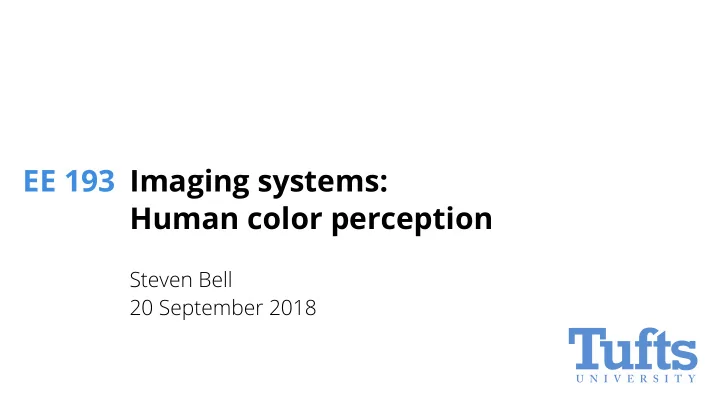

EE 193 Imaging systems: Human color perception Steven Bell 20 September 2018
Objectives Given a multispectral image of a scene and a spectral response curve, predict the appearance of the scene. Roughly sketch the spectral response curves for L, M and S cones. Explain what metamers are and why they occur. Predict the e ff ect of various forms of color blindness.
This is a ball.
Wavelength (nm) V B G Y O R 380 450 495 570 590 620 750 (wikipedia)
Daylight (D65) (wikipedia)
Other spectra http://www.chemistryland.com/CHM107Lab/ Exp7/Spectroscope/Spectroscope.html
Re fl ectance Surfaces re fl ect wavelengths di ff erently
Seeing color The eye has 3 types of cones: "long", "medium", and "short" Normalized cone response (linear energy) S M L 400 450 500 550 600 650 700 (modi fi ed from Wikipedia) Wavelength (nm)
Cone response Normalized cone response (linear energy) S M L = L 400 450 500 550 600 650 700 Wavelength (nm)
Medium cone response Normalized cone response (linear energy) S M L = M L 400 450 500 550 600 650 700 Wavelength (nm)
Short cone response Normalized cone response (linear energy) S M L = S M L 400 450 500 550 600 650 700 Wavelength (nm)
More cone responses Normalized cone response (linear energy) S M L 400 450 500 550 600 650 700 Wavelength (nm)
This is a ball.
Metamers Any two objects with di ff erent spectra but identical cone responses are called metamers. (MetaCow under D65 illumination)
Metamers Any two objects with di ff erent spectra but identical cone responses are called metamers. (MetaCow under Illuminant A)
Metamers and lighting Given what you know about metamers and light, how should we design lighting to make things "look good"? What are "good spectra" for our light bulbs to have?
Fluorescent spectra Fluorescent bulbs work by exciting a mix of gases.
LED spectra LEDs emit more or less pure wavelengths. How do we get white?
Color blindness What would happen if you were missing your L cones?
Recommend
More recommend